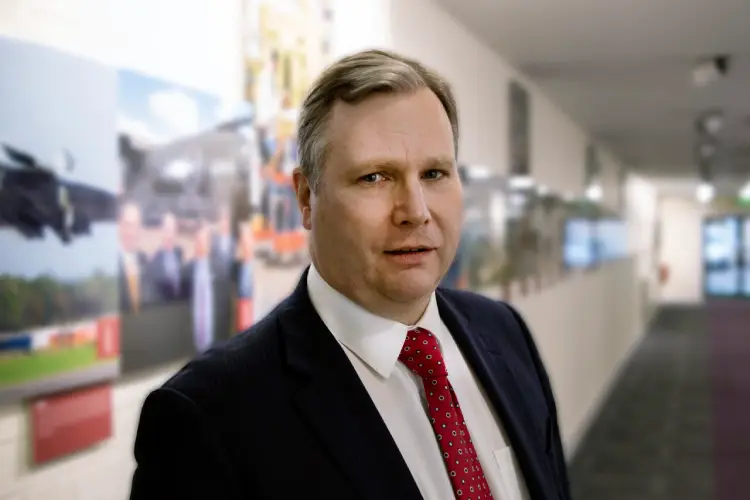
For Marshall Aerospace CTO Patrick Wood, one of the perks of the job is getting a close look at a variety of weird and wonderful aircraft.
“If I know one of the more exciting planes is in, I’ll wander down for a coffee break and take a closer look,” he says.
“We had the Blue Angels (US air force display team) C-130 here recently to be painted and modified. Seeing that roll out in its new yellow and blue colour scheme was pretty cool. The one thing I’ve missed in 2020 is not being able to go round the hangars quite so often.”
High profile planes are a familiar sight at Marshall’s headquarters – earlier this year it completed the red, white and blue paint job of the RAF Voyager that is used by the royal family and Prime Minister Boris Johnson for official trips.
But the company, which is more than 110 years old and employs 1,700 people around the world, is about much more than just eye-catching sights. It works with customers on modifying and upgrading aircraft and ground vehicles, as well as developing deployable land infrastructure such as the advanced field hospitals it has built for the Ministry of Defence. It is part of the larger Marshall Group, which also works in other areas such as automotive, and last year boasted turnover of £2.5bn.
Marshall Aerospace CTO and engineering director Wood – who has also worked in senior IT roles with the likes of Airbus and Lockheed Martin – oversees development and maintenance of the company’s IT and business information systems, as well as heading up the R&D and engineering teams.
“We have a big slice of the maintenance and repair operations (MRO) market for classic transport aircraft like the Hercules C130, but customers also come to us for technology projects like adding a new navigation or communications technology,” he says.
“The military aerospace business also has what is effectively a special mission area developing integrated surveillance and reconnaissance type aircraft, where we’ve modified business jets to become observation platforms.”
Out with the old, in with the new at Marshall Aerospace
Though Marshall is working at the cutting edge of aerospace technology, behind the scenes its systems have not always matched the progress in the cockpit, which is why it has undertaken a major digital transformation in 2020, introducing an ERP system to standardise processes across the organisation, which includes a separate module for its MRO work. Wood says the system will also help manage all suppliers and contractors and to address complex trade control requirements of the international defence industry.

“We had historic systems in our land business and military air business, and we built our own modules over the years which matched with an old MRP (material requirements planning) system,” he explains.
“It was clear to us that if we wanted to take full benefit of the digitisation, to be more rapid in our development life cycles and more efficient in our maintenance and in-service support, we needed something modern and integrated.”
Setting up their chosen solution, the IFS Applications 10 suite, has proved slightly tricky due to the Covid-19 shut-down, but Wood says the pandemic has focused the minds of many of the company’s staff on the need for digital change.
“One of the challenges you always have with a very well-established organisation is people go, ‘well, we’ve always done it this way and it’s always been successful’,” he says. “But this year has actually helped us in a few areas and enabled people to embrace the new digital culture and way of interaction.
“At board level 2020 has given us a really strong boost in terms of making sure people recognise that there is a need to accelerate the digital roadmap.”
The new system went live in the Marshall land systems business on 5 November, and from Wood’s point of view there were a pleasing lack of fireworks.
“There was a bit of concern about the implementation and training, because the IFS implementation team had never done system acceptance testing remotely, they had never done user acceptance testing remotely, and they’d never done quite so much remote training,” he says.
“But it went pretty well, and by the middle of the year we were also able to do some very socially distanced classroom training, too.”
He says key to smooth implementation was getting buy-in from across the organisation.
“The teams themselves really recognised that they needed to help in terms of making sure they were ready and that their projects were ready, and they had to undertake various data cleansing and data validation activities which proved very successful,” he adds.
Marshall Aerospace CTO: the future in the cloud, and the next generation
The priority for 2021 will be rolling out the system across other areas of the business, while Wood is also keen to take advantage of the benefits of cloud computing.
“The defence world has moved significantly to cloud-based solutions, but we tend to have to wait until they’re approved because we work with different customers with different confidentiality levels,” he says.
“Traditionally we’ve had to keep everything on-premises for security reasons, but we’re moving more systems to the cloud where it makes sense. There will always be some things that have to be stand-alone and remain on-premises, but I think we will move towards a more full-cloud set-up once we see the approvals from our various government clients.”
Recruitment is also a big priority as Wood seeks to bolster his 30-strong IT team, as well as finding the next generation of engineers to work across the business. Marshall invests heavily in apprenticeships, and with specialist skills like cybersecurity expertise in high demand, he says it is not afraid to take an unconventional approach.
“When you’re looking for those individuals who are good at things like cybersecurity, they don’t always come through the classical route,” the Marshall Aerospace CTO says. “We’ve had a lot of success through work experience and placements because you get a chance to look at how they fit with your team. Our cyber team, for example, is pretty small, so you need someone who can work effectively as part of that.
“It’s a great way to find talented people with a real desire to work in technology and information systems.”
Home page photo courtesy of Marshall Aerospace.






